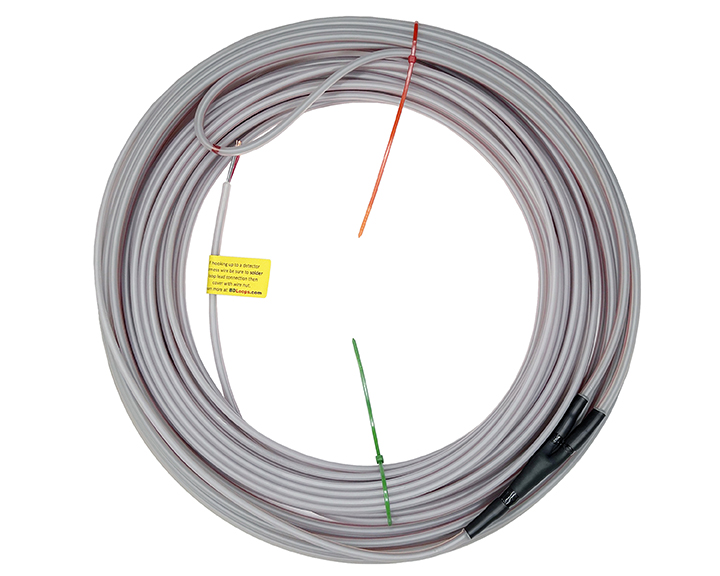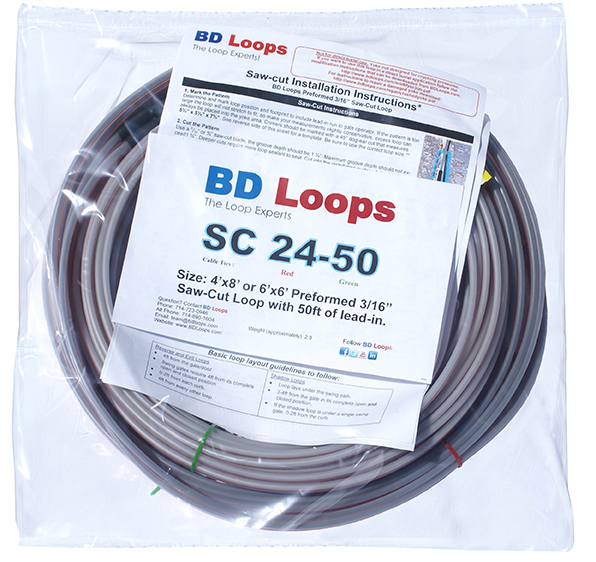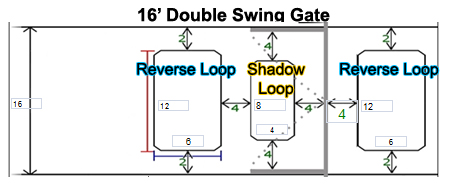description
BD Loops Preformed Saw-Cut Inductance Loops are a complete loop with a set size loop and length of lead-in run. Our Saw-Cut Loops have an extra layer of protection: a durable outer jacket that protects and tightly binds the inner conductors. All BD Loops are made with 16 AWG copper wire and rated for direct burial use.
Uses
For saw-cut installations where a 3/16” or wider slot is cut into the concrete or asphalt and the loop wire is stuffed into the saw-cut slot and sealed with loop sealant.
Standard Loop Sizes
20′ of Lead-in
| Part# | Description |
| SC 14-20 | 2½’x 4½’ or 3’x 4’ loop with a 20’ lead-in. |
| SC 16-20 | 3’x 5’ or 4’x 4’ loop with a 20’ lead-in. |
| SC 18-20 | 3’x 6’ or 4’x 5’ loop with a 20’ lead-in. |
| SC 20-20 | 3’x 7’ or 4’x 6’ loop with a 20’ lead-in. |
| SC 24-20 | 4’x 8’ or 6’x 6’ loop with a 20’ lead-in. |
| SC 32-20 | 4’x 12’ or 6’x 10’ loop with a 20’ lead-in. |
| SC 36-20 | 6’x 12’ loop with a 20’ lead-in. |
| SC 44-20 | 6’x 16’ loop with a 20’ lead-in. |
| SC 52-20 | 6’x 20’ loop with a 20’ lead-in. |
50′ Of Lead-in
| Part# | Description |
| SC 14-50 | 2½’x4½’ or 3’x4’ loop with a 50’ lead-in. |
| SC 16-50 | 3’x5’ or 4’x4’ loop with a 50’ lead-in. |
| SC 18-50 | 3’x6’ or 4’x5’ loop with a 50’ lead-in. |
| SC 20-50 | 3’x7’ or 4’x6’ loop with a 50’ lead-in. |
| SC 24-50 | 4’x8’ or 6’x6’ loop with a 50’ lead-in. |
| SC 28-50 | 4’x10’ or 6’x8’ loop with a 50’ lead-in. |
| SC 32-50 | 4’x12’ or 6’x10’ loop with a 50’ lead-in. |
| SC 36-50 | 6’x12’ loop with a 50’ lead-in. |
| SC 40-50 | 6’x14’ loop with a 50’ lead-in. |
| SC 44-50 | 6’x16’ loop with a 50’ lead-in. |
| SC 52-50 | 6’x20’ loop with a 50’ lead-in. |
100′ Of Lead-in
| Part# | Description |
| SC 24-100 | 4’x8’ or 6’x6’ loop with a 100’ lead-in. |
| SC 28-100 | 4’x10’ or 6’x8’ loop with a 100’ lead-in. |
| SC 32-100 | 4’x12’ or 6’x10’ loop with a 100’ lead-in. |
| SC 36-100 | 6’x12’ loop with a 100’ lead-in. |
| SC 40-100 | 6’x14’ loop with a 100’ lead-in. |
| SC 44-100 | 6’x16’ loop with a 100’ lead-in. |
| SC 52-100 | 6’x20’ loop with a 100’ lead-in. |
Superior Features
· Extra layer of protection—Thick and durable outer jacket protects both loop and lead-in.
· Each loop is tested 3 ways before it leaves the factory.
· Backer-rod is built into the wire! No need to use backer-rod if the loop is installed in a 3/16” saw-cut groove.
· Lead-in wires are tightly bound in an protective outer
jacket. Eliminating the need for twisting.
· Both loop and lead-in fit into a 3/16” wide saw-cut groove. No more double cutting the lead-in run!
· Loop fills up a larger percentage of the saw-cut groove, requires less loop sealant to seal the groove. (30-40% less sealant vs a 1/4” wide groove)
· Cuts don’t need to be exact! Any BD Loop can be made up to 4’ smaller. Be slightly conservative with your cuts and BD Loops Preformed Saw-Cut Loops will fit every time.
· Use the BD-LS flat 3/16″ sealant tip and seal the loop in just 1 pass. No more waiting around for the sealant to seep in and top off gaps. Make an attractive smooth and even seal.











